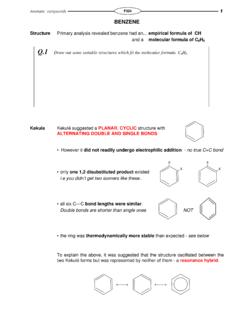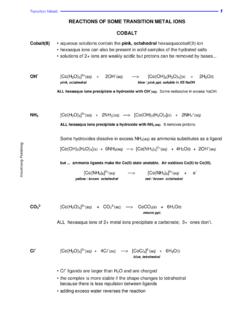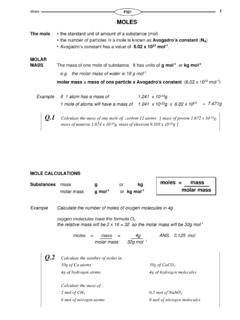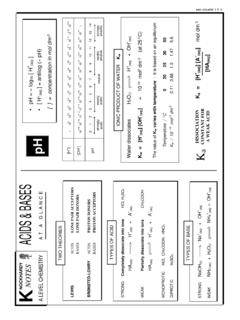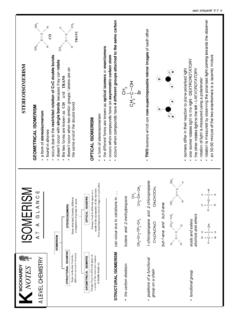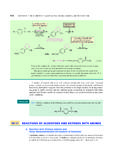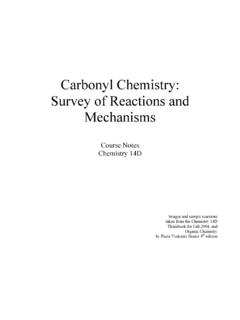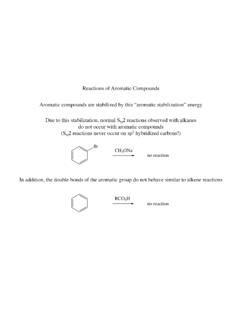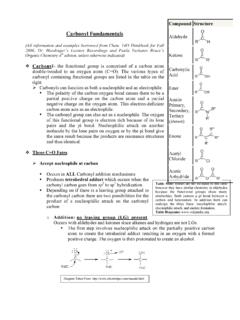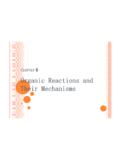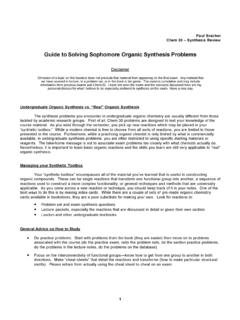Transcription of Q - knockhardy.org.uk
1 CARBONYL COMPOUNDS - Aldehydes and KetonesStructure carbonyl groups consists of a carbon-oxygen double bond the bond is polar due to the difference in electronegativity aldehydes / ketones differ in what is attached to the carbonALDEHYDES - at least one H attached to the carbonyl groupHCHO orCH3 CHOC6H5 CHOKETONES - two carbons attached to the carbonyl groupCH3 COCH3C2H5 COCH3C6H5 COCH3 Bonding the carbonyl carbon is sp2 hybridised and three sigma ( ) bonds are planar the unhybridised 2p orbital of carbon is at 90 to these it overlaps with a 2p orbital of oxygen to form a pi ( ) bond as oxygen is more electronegative than carbon the bond is polarNaming aldehydes end AL ketones end ONE pick the longest chain of carbon atoms which includes the C=O substituent positions are based on the carbon with the O attachedCH3CH2CH2CH2CH2 CHOCH3 COCH2CH2CH2CH3 hexanalhexan-2-oneCarbonyl compounds 1F324 KNOCKHARDY SCIENCE Draw structures for, and name, all the carbonyl compounds with molecular formulae.
2 A) C4H8Ob) C5H10Oc) C6H12OC=OCCC=OHCC=OHHF ormation of carbonyl compounds from alcoholsAldehydes Oxidation of primary (1 ) alcohols - risk of oxidation to acidsegCH3CH2OH(l) + [O] > CH3 CHO(l) + H2O(l) ethanol ethanalhowever, this can happenCH3 CHO(l) + [O] > CH3 COOH(l) ethanalethanoic acid it is essential to distil off the aldehyde before it gets oxidised to the acid the alcohol is dripped into a warm solution of acidified K2Cr2O7 the aldehyde has a low boiling point - no hydrogen bonding - it distils off if it didn t distil off it would be oxidised to the equivalent carboxylic acid to oxidise an alcohol straight to the acid you would reflux the mixtureKetones Oxidation of secondary (2 ) (l) + [O] > CH3 COCH3(l) + H2O(l) propan-2-ol propanone2 Carbonyl compoundsF324 KNOCKHARDY SCIENCE 2009 DISTILLATION gives anALDEHYDEREFLUXING gives aCARBOXYLIC alcohol would you use to make the following?
3 C2H5 CHO C2H5 COCH3 hexanal 3-methylhexan-2-one 3-methylpentanalCHEMICAL PROPERTIES OF CARBONYL COMPOUNDSOXIDATION provides a way of differentiating between aldehydes and ketones mild oxidising agents are best aldehydes are easier to oxidise powerful oxidising agents oxidise ketones to carboxylic acid mixturesALDEHYDES easily oxidised to acids RCHO(l) + [O] > RCOOH(l) CH3 CHO(l) + [O] > CH3 COOH(l)KETONES only oxidised under vigorous conditions to acids with fewer C2H5 COCH2CH3(l) + 3 [O] > C2H5 COOH(l) + CH3 COOH(l)Carbonyl compounds 3F324 KNOCKHARDY SCIENCE product (if any) is formed when the following undergo mild oxidation?
4 C2H5 CHO C2H5 COCH3 hexanal 3-methylhexan-2-one 3-methylpentanal cyclohexanoneIDENTIFYING A CARBONYL COMPOUNDM ethods characteristically strong peak at 1400-1600 cm-1 in the infra red spectrum or formation of orange crystalline precipitate with 2,4-dinitrophenylhydrazineBUT to narrow it down to an aldehyde or ketone you must do a second testDifferentiation to distinguish an aldehyde from a ketone you need a mild oxidising agent ..Tollens Reagent ammoniacal silver nitrate contains the diammine silver(I) ion - [Ag(NH3)2 ]+ acts as a mild oxidising agent and will oxidise aldehydes but not ketones the silver(I) ion is reduced to silverAg+(aq) + e > Ag(s) the test is known as THE SILVER MIRROR TESTF ehling s Solution contains copper(II) ions complexed with tartrate ions on warming, it will oxidise aliphatic (but not aromatic) aldehydes copper(II) is reduced to a red precipitate of copper(I) oxide, Cu2 OThe silver mirror test is the better alternative as it works with all aldehydes.
5 Ketones do not react with Tollens Reagent or Fehling s Carbonyl compoundsF324 KNOCKHARDY SCIENCE of the following produce a silver mirror with Tollens reagent? C2H5 CHO 3-methylhexan-2-one C2H5 COCH3 cyclohexanone hexanal of the following produce an orange precipitate with 2,4-dinitrophenylhydrazine? C2H5OH 3-methylhexan-2-one C2H5 COCH3 cyclohexanol hexanal 3-methylpentan-1-olNUCLEOPHILIC ADDITION REACTIONSM echanism occurs with both aldehydes and ketones involves addition to the polar C=O double bond attack is by nucleophiles at the positive carbon centre alkenes are non-polar and are attacked by electrophilesREDUCTIONR eagent sodium tetrahydridoborate(III) (sodium borohydride), NaBH4 Conditions aqueous or alcoholic solutionMechanism Nucleophilic addition (also reduction as it is addition of H )NucleophileH (hydride ion)Product(s) AldehydesREDUCED to primary (1 ) alcoholsKetonesREDUCED to secondary (2 ) alcoholsEquation(s)
6 CH3 CHO + 2[H] > CH3CH2OH CH3 COCH3 + 2[H] > CH3 CHOHCH3 Step 1H is a nucleophile and attacks the C +An electron pair from the C=C moves onto O making it -iveStep 2A lone pair on oxygen removes a proton from waterOverall, there is addition of hydrogen (reduction)Carbonyl compounds 5F324 KNOCKHARDY SCIENCE 2009 BondPolarityAttacked byResultCarbonylC=OPolarNucleophilesAddi tionAlkeneC=CNon-polarElectrophilesAddit ionCHOCH3 OHHCCH3 HCCH3 HOHHOHOH+ a diagram to indicatethe bonding in NaBH4. AlternativeMethodReagent hydrogenConditions catalyst - nickel or platinumReaction type Hydrogenation, reductionEquation(s)CH3 CHO + H2 > CH3CH2 OHCH3 COCH3 + H2 > CH3 CHOHCH3 NoteHydrogen also reduces C=C = CHCHO + 2H2 > CH3CH2CH2OH6 Carbonyl compoundsF324 KNOCKHARDY SCIENCE structures of the organic products formed when the following are reduced NaBH4 H2 OOHOCH = CHCH are C=C double bonds NOT reduced when NaBH4 is used?
7 HCNR eagenthydrogen cyanide - HCN (in the presence of KCN)Conditionsreflux in alkaline solutionNucleophilecyanide ion CN Product(s)hydroxynitrile (cyanohydrin)Equation CH3 CHO + HCN > CH3CH(OH)CN 2-hydroxypropanenitrileMechanismNucleoph ilic additionStep 1CN acts as a nucleophile and attacks the slightly positive C One of the C=O bonds breaks; a pair of electrons goes onto the OStep 2A pair of electrons is used to form a bond with H+Overall, there has been addition of HCNN otes HCN is a weak acid ; HCN H+ + CN few CN ions produced the reaction is catalysed by alkali - produces more of the nucleophilic CN watch out for the possibility of optical isomerism in hydroxynitrilesCN attacksfrom aboveCN attacksfrom belowCarbonyl compounds 7F324 KNOCKHARDY SCIENCE 2009 CHOCH3N C _HCCH3 NCOH+HCCH3 NCOHCHOCH3N C _HCCH3 NCOH+HCCH3 NCOHCHOCH3N C _OHHCCH3 NCHCCH3 NCOH+2,4-DINITROPHENYLHYDRAZINEC6H3(NO2) 2 NHNH2 Theory reacts with carbonyl compounds (aldehydes and ketones)
8 Used as a simple test for aldehydes and ketones makes orange crystalline derivatives - 2,4-dinitrophenylhydrazones derivatives have sharp, well-defined melting points also used to characterise (identify) carbonyl A simple way of characterising a compound (finding out what it is) is to measure the melting point of a solid the boiling point of a liquidThe following structural isomers have similar boiling points because of similar vander Waals forces and dipole-dipole interactions. They would be impossible toidentify with any precision using boiling point point of compound 213 C 214 C 214 CMelting point of 2,4-dnph derivative 209 C 248 C 265 C By forming the 2,4-dinitrophenylhydrazone derivatives and taking the melting pointof the purified, crystalline product, it is easy to identify the original Carbonyl compoundsF324 KNOCKHARDY SCIENCE 20092NH NH2NO2 NOClCHOClCHOClCHOisomericchlorophenylmet hanalsNO2NO22NH NH3CH CHO+NO2NO2N NC3 CHHH2H O+Carbonyl compounds 9F324 KNOCKHARDY SCIENCE a method for differentiating between the following.
9 What would be seen? C2H5 CHO and C2H5 COCH3 C3H7 COCH3 and C2H5 COC2H5 hexanal and out equations for the reactions between HCN C2H5 CHO + HCN > CH3 COCH3 + HCN > hexanal + HCN >Indicate which reactions give rise to optically active organic compounds?Why is the addition of HCN such a useful reaction?
